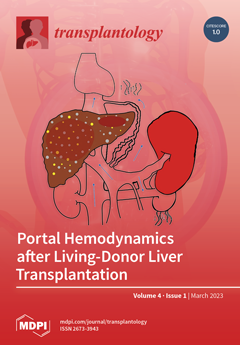Open AccessArticle
The Non-Muscle-Splitting Mini-Incision Donor Nephrectomy Remains a Feasible Technique in the Laparoscopic Era of Living Kidney Donation
by
Lex J. M. Habets, Andrzej G. Baranski, Khalil Ramdhani, Danny van der Helm, Ada Haasnoot, Aiko P. J. de Vries, Koen E. A. van der Bogt, Andries E. Braat, Jeroen Dubbeld, Hwai-Ding Lam, Jeroen Nieuwenhuizen, Willemijn N. Nijboer, Dorottya. K. de Vries, Ian P. J. Alwayn, Alexander F. M. Schaapherder and Volkert A. L. Huurman
Cited by 2 | Viewed by 2451
Abstract
Laparoscopic donor nephrectomy (LDN) is the current gold standard in kidney donation. Mini-incision open donor nephrectomy (MINI) techniques have been used extensively but have become less popular. The aim of the present study was to compare the results and safety of a non-muscle-splitting
[...] Read more.
Laparoscopic donor nephrectomy (LDN) is the current gold standard in kidney donation. Mini-incision open donor nephrectomy (MINI) techniques have been used extensively but have become less popular. The aim of the present study was to compare the results and safety of a non-muscle-splitting MINI technique with the current gold standard of LDN. A single center retrospective cohort study of all living donor nephrectomies between 2011 and 2019 was used for the study. The primary outcome of this study was short term (<30 days) with Clavien–Dindo grade complications. Secondary outcomes included multivariable regression analysis of perioperative data. No differences in complication rates were observed between MINI and LDN and also after correction for known confounders. As expected, the operative time and first warm ischemia were significantly shorter in the MINI group and less blood loss was observed in the LDN group. Complications and conversion rate (LDN to open) among the LDN patients were in line with recent published meta-analyses. This study confirms the perioperative safety of living kidney donation in modern practice. Complication rates of both MINI and LDN procedures are limited and not different between procedures. In specific circumstances, the MINI procedure can still be considered a safe and feasible alternative for living kidney donation.
Full article
►▼
Show Figures




